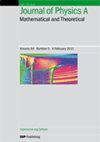Clifford orbits and stabilizer states
IF 2.1
3区 物理与天体物理
Q2 PHYSICS, MATHEMATICAL
Journal of Physics A: Mathematical and Theoretical
Pub Date : 2024-09-11
DOI:10.1088/1751-8121/ad7710
引用次数: 0
Abstract
Stabilizer states serve as ‘classical objects’ in the stabilizer formalism of quantum theory, and play an important role in quantum error correction, fault-tolerant quantum computation, and quantum communication. They provide an efficient description of many basic features of quantum theory and exhibit a rich structure. For prime dimensional systems, they may be defined by two quite different yet equivalent ways: The first is via stabilizer groups (maximal Abelian subgroups of the discrete Heisenberg–Weyl group). The second is via the orbits of the Clifford group acting on any computational basis state. However, in a general dimensional system, this equivalence breaks down, and consequently, it is desirable to clarify the difference and relation between the above two approaches to stabilizer states. In this work, we show that these two approaches are equivalent if and only if the system dimension is square-free (i.e. has no square factor). Furthermore, we completely reveal the relation between the Clifford orbits and stabilizer states in an arbitrary dimensional system, derive the explicit expressions of the Clifford orbits and determine their cardinalities.克利福德轨道和稳定器状态
稳定器态是量子理论稳定器形式主义中的 "经典对象",在量子纠错、容错量子计算和量子通信中发挥着重要作用。它们有效地描述了量子理论的许多基本特征,并展现出丰富的结构。对于质维系统,它们可以通过两种完全不同但等价的方式来定义:第一种是通过稳定器群(离散海森堡-韦尔群的最大阿贝尔子群)。第二种是通过作用于任何计算基态的克利福德群的轨道。然而,在一般维度的系统中,这种等价关系被打破了,因此,我们需要澄清上述两种稳定器状态方法之间的区别和关系。在这项工作中,我们证明了这两种方法是等价的,当且仅当系统维数是无平方的(即没有平方因子)。此外,我们完全揭示了任意维系统中克利福德轨道与稳定器状态之间的关系,推导出了克利福德轨道的明确表达式,并确定了它们的心数。
本文章由计算机程序翻译,如有差异,请以英文原文为准。
求助全文
约1分钟内获得全文
求助全文
来源期刊
CiteScore
4.10
自引率
14.30%
发文量
542
审稿时长
1.9 months
期刊介绍:
Publishing 50 issues a year, Journal of Physics A: Mathematical and Theoretical is a major journal of theoretical physics reporting research on the mathematical structures that describe fundamental processes of the physical world and on the analytical, computational and numerical methods for exploring these structures.

 求助内容:
求助内容: 应助结果提醒方式:
应助结果提醒方式:


